Phase Separation Study on the Storage of Technically Specification Natural Rubber Modified Bitumen
Abstract
1. Introduction
2. Materials and Methods
2.1. Material
2.2. Methods
2.2.1. Preparation of Materials
2.2.2. TSNR-Modified Asphalt Production
2.2.3. TSNR-Modified Asphalt Characteristics Test
2.2.4. Storage Stability Simulation of TSNR-Modified Asphalt
3. Results and Discussion
3.1. Penetration of Technically Specified Natural Rubber (TSNR)-Modified Asphalt before Storage Stability Tests
3.2. Softening Point of Technically Specified Natural Rubber (TSNR)-Modified Asphalt before Storage Stability Test
3.3. Storage Stability of TSNR-Modified Asphalt
3.4. Effects of Sulfur Addition and Decreased Storage Temperature on Storage Stability of TSNR-Modified Asphalt
3.5. Density and Viscosity of TSNR-Modified Asphalt
3.6. Determination of Phase Separation Flow Velocity in TSNR-Modified Asphalt
3.7. Phase Separation Simulation of TSNR-Modified Asphalt
- The TSNR-modified asphalt production process must pay attention to the particle size used, the melting temperature of the TSNR, and the mixing time between the asphalt components and TSNR. The TSNR particle size in the mixture must be maintained in the range of 100 to 150 nm; this is necessary to avoid increasing the number of maltene fractions, which can reduce the quality of asphalt in terms of its adhesion, cohesion, and elasticity properties. The particle size can be kept constant by paying attention to the melting temperature and mixing time. The optimum melting temperature for TSNR is 200 °C; higher temperatures can degrade some TSNR and will increase the number of maltene fractions in the modified asphalt mixture. Apart from that, the length of mixing time also influences the degradation of the TSNR phase.
- It is recommended to store TSNR-modified asphalt at a temperature of 160 °C for only 12 h. This is considered necessary to avoid phase separation in TSNR-modified asphalt. Based on the simulation results, it was found that TSNR-modified asphalt can only be stored for 12 h, and longer storage causes coalescence and flocculation phenomena, which ultimately accelerate the phase separation. It is also recommended that the hot-mix manufacturing process uses TSNR-modified asphalt, which is stored at room temperature.
- It is recommended that additives be added to the TSNR-modified asphalt mixture separately to avoid faster phase separation in the modified asphalt. Adding additives such as sulfur in the modified asphalt mixture can cause a spontaneous vulcanization reaction at a storage temperature of 160 °C, destabilizing the TSNR phase in the mixture. As a result, several TSNR phases clot and can clog the piping in the AMP.
- Conduct periodic softening point and density tests on TSNR-modified asphalt at the top and bottom if necessary. Suppose that TSNR-modified asphalt is found to have a difference in softening point at the top and bottom of more than 2.2 °C and a difference in density of more than 10%. In that case, it is recommended that the modified asphalt be stirred again to distribute the TSNR phase in the mixture.
- Mixing asphalt with aggregate in hot mix production takes 2–3 min longer. This is important because TSNR-modified asphalt has a much higher viscosity than conventional asphalt. Therefore, it takes a longer mixing time for the asphalt to cover the aggregate surface to optimize the binding of the asphalt and aggregate after compaction.
4. Conclusions
- Modified asphalt with TSNR 8, 10, and 12% without sulfur or with sulfur shows phase separation after storage stability tests at temperatures of 130 °C and 160 °C for 48 h, with a more significant difference in soft point than the required 2.2° C.
- Adding sulfur additives to the TSNR-modified asphalt mixture does not much help increase its storage stability. However, it increases the softening point of the modified asphalt at the top and bottom.
- TSNR-modified asphalt with the best storage stability was obtained by adding 10% TSNR without sulfur with the difference in softening point after the storage stability test reaching 11.6 °C after 48 h of storage and continuing to increase until it reached 13.9 °C after 72 h of storage.
- The combination of the fluid flow model with the incompressible Navier–Stokes and phase field equations accurately describes the phase separation in TSNR-modified asphalt, with simulation results showing that asphalt modified with 8, 10, and 12% TSNR is stored optimally at a temperature of 160 °C for 12 h without stirring.
- Simulations using the fluid flow model with the incompressible Navier–Stokes and phase field equations show that the phase separation of TSNR-modified asphalt can last up to 96 h.
Author Contributions
Funding
Institutional Review Board Statement
Informed Consent Statement
Data Availability Statement
Acknowledgments
Conflicts of Interest
References
- Becker, Y.; Méndez, M.P.; Rodríguez, Y. Polymer modified asphalt. Vis. Tecnol. 2001, 9, 39–50. [Google Scholar]
- Read, J.; Whiteoak, D. The Shell Bitumen Handbook, 6th ed.; Emerald Publishing: Bingley, UK, 2015. [Google Scholar] [CrossRef]
- Speight, J.G. Asphalt Materials Science and Technology; Elsevier: Amsterdam, The Netherlands, 2015. [Google Scholar] [CrossRef]
- Ibrahim, B.; Wiranata, A.; Malik, A. The effect of addition of antioxidant 1,2-dihydro-2,2,4-trimethyl-quinoline on characteristics of crepe rubber modified asphalt in short term aging and long term aging conditions. Appl. Sci. 2020, 10, 7236. [Google Scholar] [CrossRef]
- Alfayez, S.A.; Suleiman, A.R.; Nehdi, M.L. Recycling tire rubber in asphalt pavements: State of the art. Sustainability 2020, 12, 9076. [Google Scholar] [CrossRef]
- Zhu, J.; Balieu, R.; Lu, X.; Kringos, N. Numerical Prediction of Storage Stability of Polymer-Modified Bitumen: A Coupled Model of Gravity-Driven Flow and Diffusion. Transp. Res. Rec. 2017, 2632, 70–78. [Google Scholar] [CrossRef]
- Brasileiro, L.; Moreno-Navarro, F.; Tauste-Martínez, R.; Matos, J.; Rubio-Gámez, M.D.C. Reclaimed polymers as asphalt binder modifiers for more sustainable roads: A review. Sustainability 2019, 11, 646. [Google Scholar] [CrossRef]
- Saowapark, W.; Jubsilp, C.; Rimdusit, S. Natural rubber latex-modified asphalts for pavement application: Effects of phosphoric acid and sulphur addition. Road Mater. Pavement Des. 2019, 20, 211–224. [Google Scholar] [CrossRef]
- Azahar, N.M.; Hassan, N.A.; Putrajaya, M.R.; Hainin, R.; Puan, O.C.; Shukry, N.A.M.; Hezmi, M.A. Engineering properties of asphalt binder modified with cup lump rubber. IOP Conf. Ser. Earth Environ. Sci. 2019, 220, 012014. [Google Scholar] [CrossRef]
- Wen, Y.; Wang, Y.; Zhao, K.; Sumalee, A. The use of natural rubber latex as a renewable and sustainable modifier of asphalt binder. Int. J. Pavement Eng. 2017, 18, 547–559. [Google Scholar] [CrossRef]
- McNally, T. Polymer Modified Bitumen: Properties and Characterisation. Mater. Res. Innov. 2011, 16, 1–6. [Google Scholar] [CrossRef]
- Shaffie, E.; Arshad, A.K.; Alisibramulisi, A.; Ahmad, J.; Hashim, W.; Abd Rahman, Z.; Jaya, R.P. Effect of mixing variables on physical properties of modified bitumen using natural rubber latex. Int. J. Civ. Eng. Technol. 2018, 9, 1812–1821. [Google Scholar]
- Shaffie, E.; Hanif, W.M.M.W.; Arshad, A.K.; Hashim, W. Rutting resistance of asphalt mixture with cup lumps modified binder. IOP Conf. Ser. Mater. Sci. Eng. 2017, 271, 012056. [Google Scholar] [CrossRef]
- Bahruddin; Arya, W.; Yanny, S.; Alfian, M. Effects of cup lump natural rubber as an additive on the characteristics of asphalt-rubber products. IOP Conf. Ser. Mater. Sci. Eng. 2020, 845, 012050. [Google Scholar] [CrossRef]
- Bahruddin; Wiranata, A.; Malik, A. Effects of 1,2-dihydro-2,2,4-trimethyl-quinoline (TMQ) antioxidant on the Marshall characteristics of crepe rubber modified asphalt. Key Eng. Mater. 2021, 876, 39–44. [Google Scholar] [CrossRef]
- Zhu, J.; Lu, X.; Balieu, R.; Kringos, N. Modelling and numerical simulation of phase separation in polymer modified bitumen by phase-field method. Mater. Des. 2016, 107, 322–332. [Google Scholar] [CrossRef]
- Zhu, J.; Birgisson, B.; Kringos, N. Polymer modification of bitumen: Advances and challenges. Eur. Polym. J. 2014, 54, 18–38. [Google Scholar] [CrossRef]
- Xiao, F.; Zong, Q.; Wang, J.; Chen, J.; Liu, J. Storage stability characterization and improvement of SBS and crumb rubber composite modified asphalt. Road Mater. Pavement Des. 2020, 23, 509–526. [Google Scholar] [CrossRef]
- Liang, M.; Xin, X.; Fan, W.; Luo, H.; Wang, X.; Xing, B. Investigation of the rheological properties and storage stability of CR/SBS modified asphalt. Constr. Build. Mater. 2015, 74, 235–240. [Google Scholar] [CrossRef]
- Zhu, J.; Lu, X.; Kringos, N. Experimental investigation on storage stability and phase separation behaviour of polymer-modified bitumen. Int. J. Pavement Eng. 2018, 19, 832–841. [Google Scholar] [CrossRef]
- Wang, H.; Liu, X.; Erkens, S.; Skarpas, A. Experimental characterization of storage stability of crumb rubber modified bitumen with warm-mix additives. Constr. Build. Mater. 2020, 249, 118840. [Google Scholar] [CrossRef]
- Liang, M.; Xin, X.; Fan, W.; Sun, H.; Yao, Y.; Xing, B. Viscous properties, storage stability and their relationships with microstructure of tire scrap rubber modified asphalt. Constr. Build. Mater. 2015, 74, 124–131. [Google Scholar] [CrossRef]
- Azahar, N.M.; Hassan, N.A.; Jaya, R.P.; Hainin, M.R.; Yusoff, N.I.M.; Kamaruddin, N.H.M.; Yunus, N.Z.M.; Hassan, S.A.; Yaacob, H. Properties of cup lump rubber modified asphalt binder. Road Mater. Pavement Des. 2019, 22, 1329–1349. [Google Scholar] [CrossRef]
- Abdulrahman, S.; Hainin, M.R.; Idham, M.K.; Hassan, N.A.; Warid, M.N.M.; Yaacob, H.; Azman, M.; Puan, O.C. Physical properties of warm cup lump modified bitumen. IOP Conf. Ser. Mater. Sci. Eng. 2019, 527, 012048. [Google Scholar] [CrossRef]
- Rohayzi, N.F.; Katman, H.Y.B.; Ibrahim, M.R.; Norhisham, S.; Rahman, N.A. Potential Additives in Natural Rubber-Modified Bitumen: A Review. Polymers 2023, 15, 1951. [Google Scholar] [CrossRef] [PubMed]
- Al-Mansob, R.A.; Ismail, A.; Alduri, A.N.; Azhari, C.H.; Karim, M.R.; Yusoff, N.I.M. Physical and rheological properties of epoxidized natural rubber modified bitumens. Constr. Build. Mater. 2014, 63, 242–248. [Google Scholar] [CrossRef]
- Al-Mansob, R.A.; Ismail, A.; Yusoff, N.I.M.; Azhari, C.H.; Karim, M.R.; Alduri, A.; Baghini, M.S. Rheological characteristics of epoxidized natural rubber modified bitumen. Appl. Mech. Mater. 2014, 505–506, 174–179. [Google Scholar] [CrossRef]
- Poovaneshvaran, S.; Hasan, M.R.M.; Jaya, R.P. Impacts of recycled crumb rubber powder and natural rubber latex on the modified asphalt rheological behaviour, bonding, and resistance to shear. Constr. Build. Mater. 2020, 234, 117357. [Google Scholar] [CrossRef]
- Fang, C.; Qiao, X.; Yu, R.; Yu, X.; Liu, J.; Yu, J.; Xia, R. Influence of modification process parameters on the properties of crumb rubber/EVA modified asphalt. J. Appl. Polym. Sci. 2016, 133, 27. [Google Scholar] [CrossRef]
- Yu, C.; Hu, K.; Yang, Q.; Wang, D.; Zhang, W.; Chen, G.; Kapyelata, C. Analysis of the storage stability property of carbon nanotube/recycled polyethylene-modified asphalt using molecular dynamics simulations. Polymers 2021, 13, 1658. [Google Scholar] [CrossRef] [PubMed]
- ASTM Standard D5-06; Standard Test Method for Penetration of Bituminous Materials. ASTM International: West Conshohocken, PA, USA, 2006. [CrossRef]
- ASTM Standard D36-06; Standard Test Method for Softening Point of Bitumen (Ring-and-Ball Apparatus). ASTM International: West Conshohocken, PA, USA, 2006. [CrossRef]
- ASTM Standard D6-95; Standard Test Method for Loss on Heating of Oil and Asphaltic Compounds. ASTM International: West Conshohocken, PA, USA, 1995. [CrossRef]
- ASTM Standard D113-17; Standard Test Method for Ductility of Asphalt Materials. ASTM International: West Conshohocken, PA, USA, 2017. [CrossRef]
- ASTM Standard D6927-22; Standard Test Method for Marshall Stability and Flow of Asphalt Mixtures. ASTM International: West Conshohocken, PA, USA, 2022. [CrossRef]
- ASTM Standard D2170-07; Standard Test Method for Kinematic Viscosity of Asphalts (Bitumens). ASTM International: West Conshohocken, PA, USA, 2007. [CrossRef]
- ASTM Standard D70-18a; Standard Test Method for Density of Semi-Solid Asphalt Binder (Pycnometer Method). ASTM International: West Conshohocken, PA, USA, 2018. [CrossRef]
- ASTM Standard D7173-20; Standard Practice for Determining the Separation Tendency of Polymer from Polymer-Modified Asphalt. ASTM International: West Conshohocken, PA, USA, 2020. [CrossRef]
- Ren, S.; Liu, X.; Fan, W.; Wang, H.; Erkens, S. Rheological Properties, Compatibility, and Storage Stability of SBS Latex-Modified Asphalt. Materials 2019, 12, 3683. [Google Scholar] [CrossRef]
- Xia, C.; Chen, M.; Geng, J.; Liao, X.; Chen, Z. Swelling and Degradation Characteristics of Crumb Rubber Modified Asphalt during Processing. Math. Probl. Eng. 2021, 2021, 6682905. [Google Scholar] [CrossRef]
- Behnood, A.; Gharehveran, M.M. Morphology, rheology, and physical properties of polymer-modified asphalt binders. Eur. Polym. J. 2019, 112, 766–791. [Google Scholar] [CrossRef]
- Pérez-Lepe, A.; Martínez-Boza, F.J.; Attané, P.; Gallegos, C. Destabilization mechanism of polyethylene-modified bitumen. J. Appl. Polym. Sci. 2006, 100, 260–267. [Google Scholar] [CrossRef]
- Wieser, M.; Schaur, A.; Unterberger, S.H. Polymer-bitumen interaction: A correlation study with six different bitumens to investigate the influence of sara fractions on the phase stability, swelling, and thermo-rheological properties of sbs-pmb. Materials 2021, 14, 1273. [Google Scholar] [CrossRef] [PubMed]
- Wang, H.; Liu, X.; Apostolidis, P.; Erkens, S.; Skarpas, A. Experimental Investigation of Rubber Swelling in Bitumen. Transp. Res. Rec. 2020, 2674, 203–212. [Google Scholar] [CrossRef]
- Wang, S.; Cheng, D.; Xiao, F. Recent developments in the application of chemical approaches to rubberized asphalt. Constr. Build. Mater. 2017, 131, 101–113. [Google Scholar] [CrossRef]
- Shafii, M.A.; Lai Yew Veng, C.; Mohamad Rais, N.; Ab Latif, A. Effect of blending temperature and blending time on physical properties of NRL-modified bitumen. Int. J. Appl. Eng. Res. 2017, 12, 3844–3849. [Google Scholar]
- Wang, Z.; Ye, F. Experimental investigation on aging characteristics of asphalt based on rheological properties. Constr. Build. Mater. 2020, 231, 117158. [Google Scholar] [CrossRef]
- Xie, J.; Yang, Y.; Lv, S.; Peng, X.; Zhang, Y. Investigation on preparation process and storage stability of modified asphalt binder by grafting activated crumb rubber. Materials 2019, 12, 2014. [Google Scholar] [CrossRef] [PubMed]
- Hofko, B.; Eberhardsteiner, L.; Füssl, J.; Grothe, H.; Handle, F.; Hospodka, M.; Grossegger, D.; Nahar, S.N.; Schmets, A.J.M.; Scarpas, A. Impact of maltene and asphaltene fraction on mechanical behavior and microstructure of bitumen. Mater. Struct. Constr. 2016, 49, 829–841. [Google Scholar] [CrossRef]
- Celauro, C.; Bosurgi, G.; Sollazzo, G.; Ranieri, M. Laboratory and in-situ tests for estimating improvements in asphalt concrete with the addition of an LDPE and EVA polymeric compound. Constr. Build. Mater. 2019, 196, 714–726. [Google Scholar] [CrossRef]
- Xu, J.; Li, R.; Liu, T.; Pei, J.; Li, Y.; Luo, Q. Study on the effect of microwave processing on asphalt-rubber. Materials 2020, 13, 411. [Google Scholar] [CrossRef] [PubMed]
- Lushinga, N.; Cao, L.; Dong, Z.; Assogba, C.O. Improving storage stability and physicochemical performance of styrene-butadiene-styrene asphalt binder modified with nanosilica. Sustainability 2020, 12, 8968. [Google Scholar] [CrossRef]
- Zhu, J. Storage Stability and Phase Separation Behaviour of Polymer-Modified Bitumen: Characterization and Modelling. Ph.D. Thesis, KTH Royal Institute of Technology, Stockholm, Sweden, 2016. [Google Scholar]
- Liang, M.; Xin, X.; Fan, W.; Ren, S.; Liang, M.; Shi, J. Effects of polymerized sulfur on rheological properties, morphology and stability of SBS modified asphalt. Constr. Build. Mater. 2017, 150, 860–871. [Google Scholar] [CrossRef]
- Kumar, A.; Choudhary, R.; Kumar, A. Characterization of thermal storage stability of waste plastic pyrolytic char modified asphalt binders with sulfur. PLoS ONE 2021, 16, e0248465. [Google Scholar] [CrossRef] [PubMed]
- Zhang, F.; Yu, J.; Wu, S. Effect of ageing on rheological properties of storage-stable SBS/sulfur-modified asphalts. J. Hazard. Mater. 2010, 182, 507–517. [Google Scholar] [CrossRef]
- Zhu, J.; Balieu, R.; Wang, H. The use of solubility parameters and free energy theory for phase behaviour of polymer-modified bitumen: A review. Road Mater. Pavement Des. 2019, 22, 757–778. [Google Scholar] [CrossRef]
- Lv, Q.; Huang, W.; Tang, N.; Xiao, F. Comparison and relationship between indices for the characterization of the moisture resistance of asphalt–aggregate systems. Constr. Build. Mater. 2018, 168, 580–589. [Google Scholar] [CrossRef]
- Coran, A.Y. Vulcanization. In The Science and Technology of Rubber; Academic Press: Cambridge, MA, USA, 2013. [Google Scholar] [CrossRef]
- Padhan, R.K.; Gupta, A.A.; Sreeram, A. Effect of cross-linking agent on ethylene vinyl acetate/polyoctenamer modified bitumen. Road Mater. Pavement Des. 2019, 20, 1615–1623. [Google Scholar] [CrossRef]
- Memon, N.A.; Yusoff, N.I.M.; Jafri, S.F.; Sheeraz, K. Rheological Findings on Storage Stability for Chemically Dispersed Crumb Rubber Modified Bitumen. Constr. Build. Mater. 2021, 305, 124768. [Google Scholar] [CrossRef]
- Kim, H.; Lee, S.-J. Laboratory Investigation of Different Standards of Phase Separation in Crumb Rubber Modified Asphalt Binders. J. Mater. Civ. Eng. 2013, 25, 1975–1978. [Google Scholar] [CrossRef]
- Porto, M.; Caputo, P.; Loise, V.; Eskandarsefat, S.; Teltayev, B.; Rossi, C.O. Bitumen and bitumen modification: A review on latest advances. Appl. Sci. 2019, 9, 742. [Google Scholar] [CrossRef]
- Comsol. Two-Phase Flow Modeling Guidelines. 2020. Available online: https://www.comsol.com/support/knowledgebase/1239 (accessed on 5 August 2023).
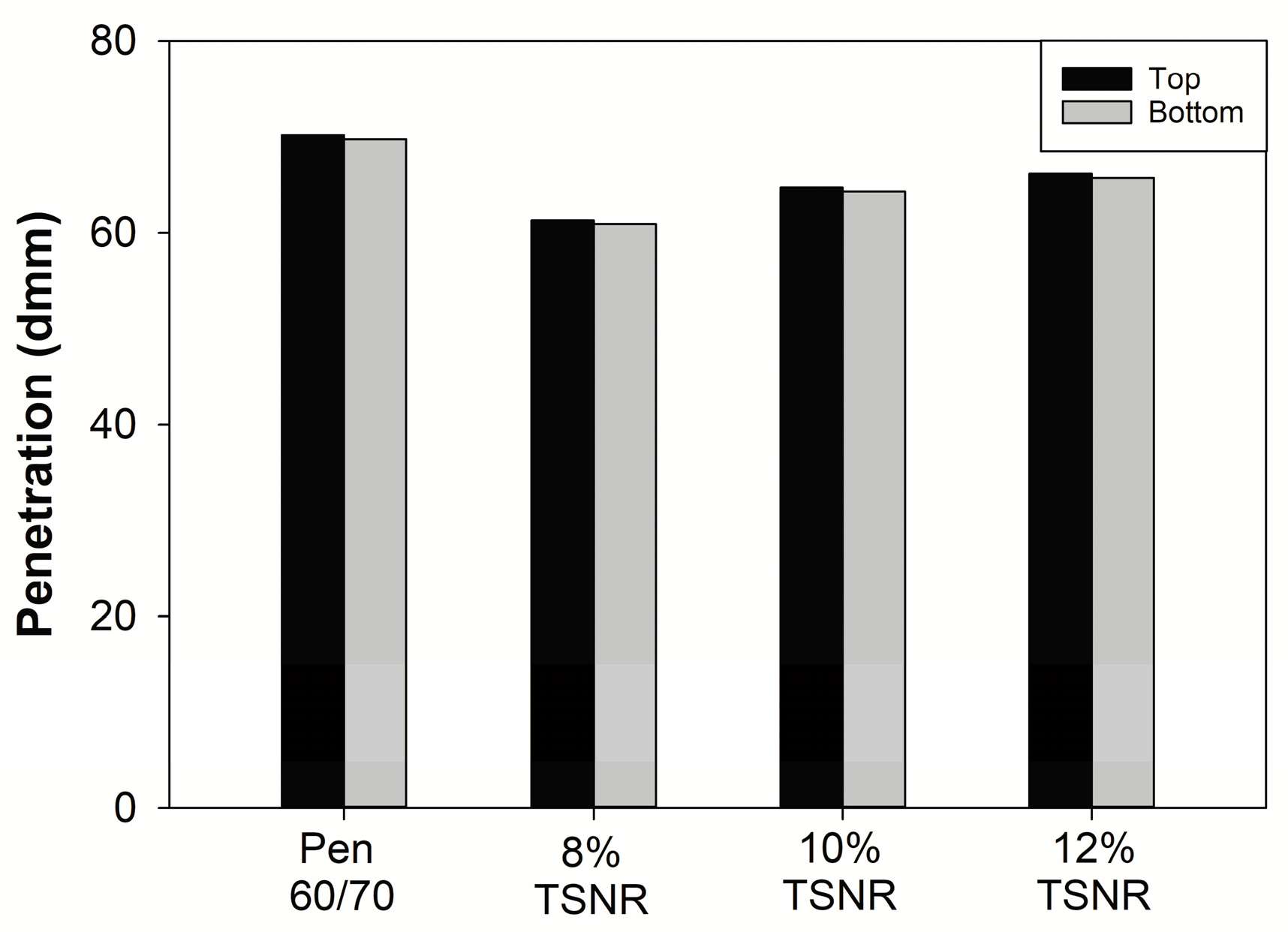
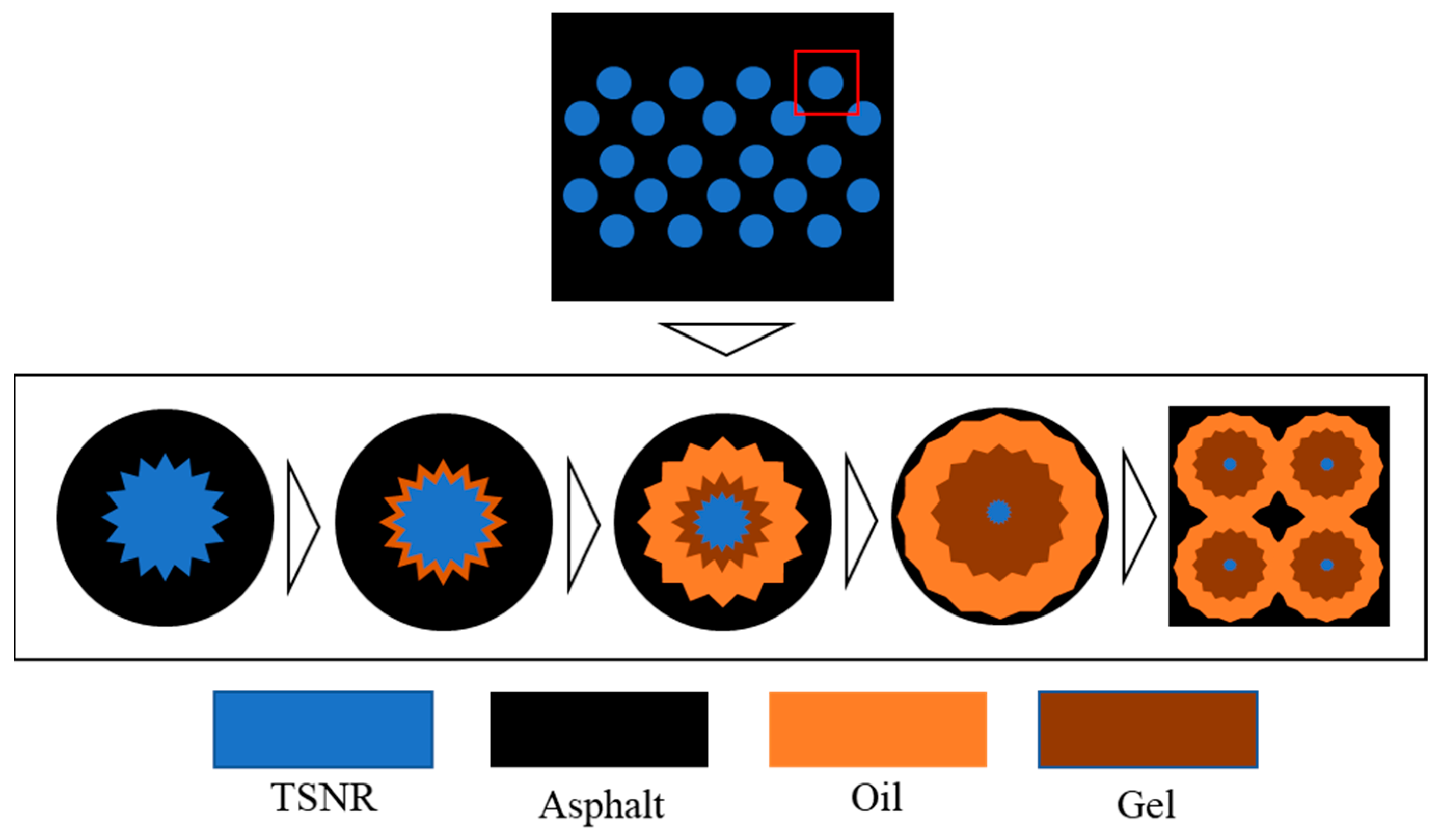

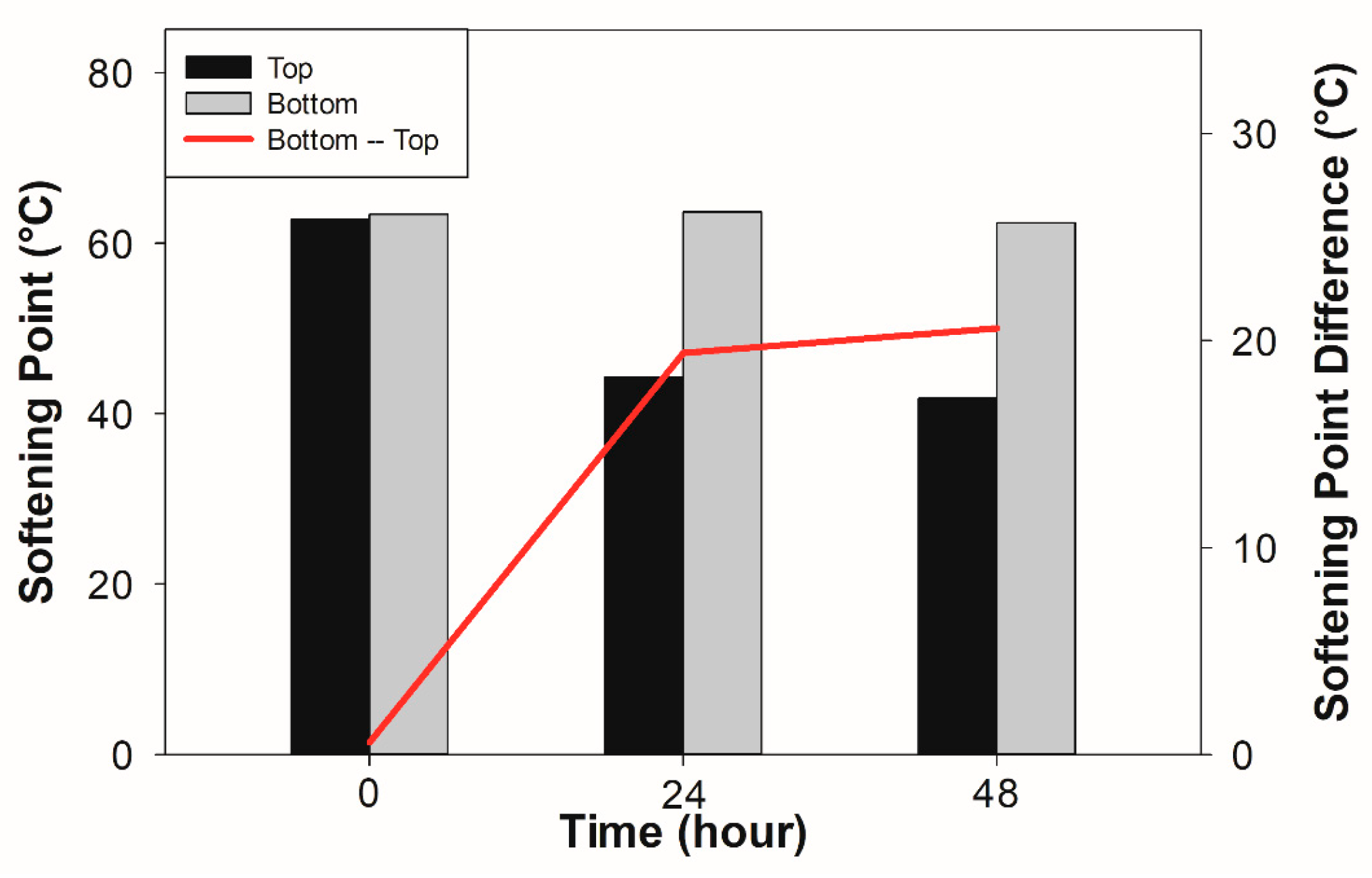





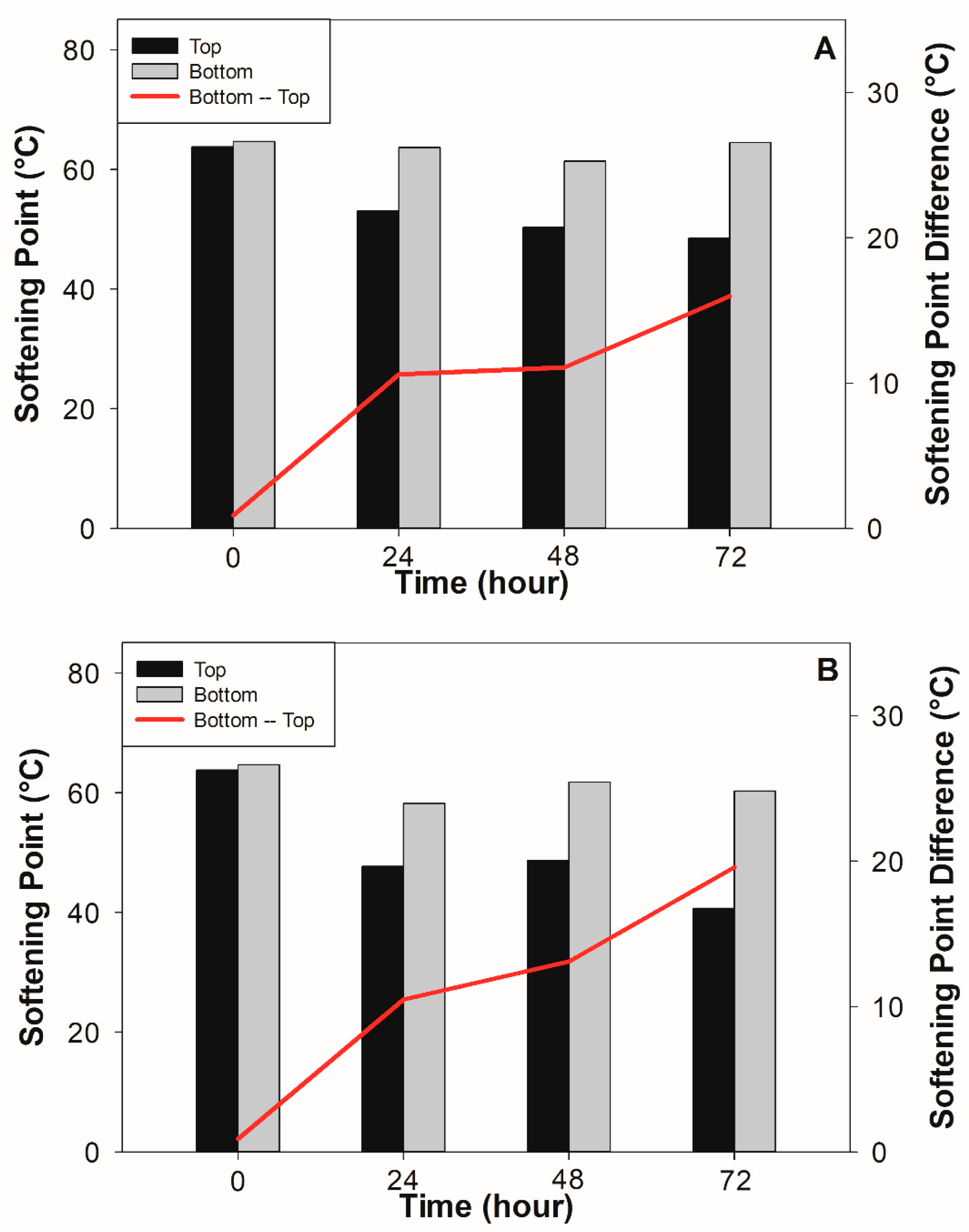
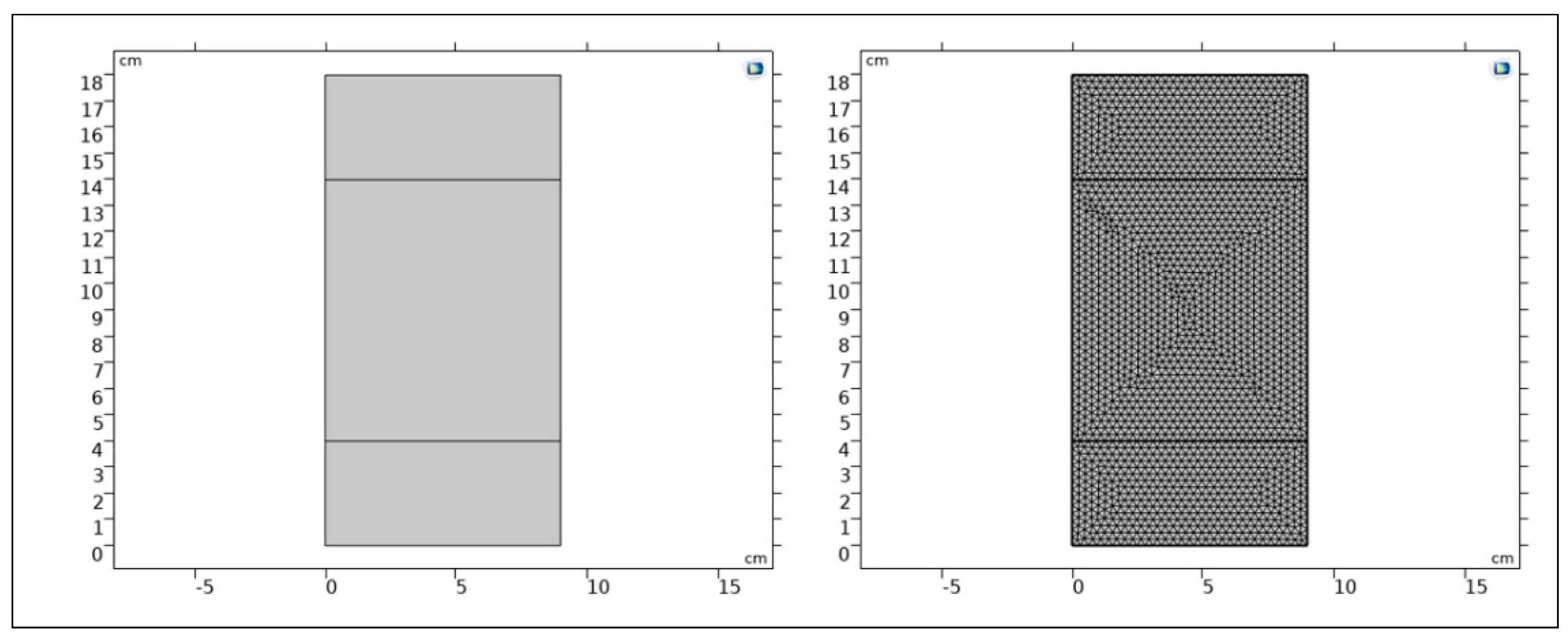
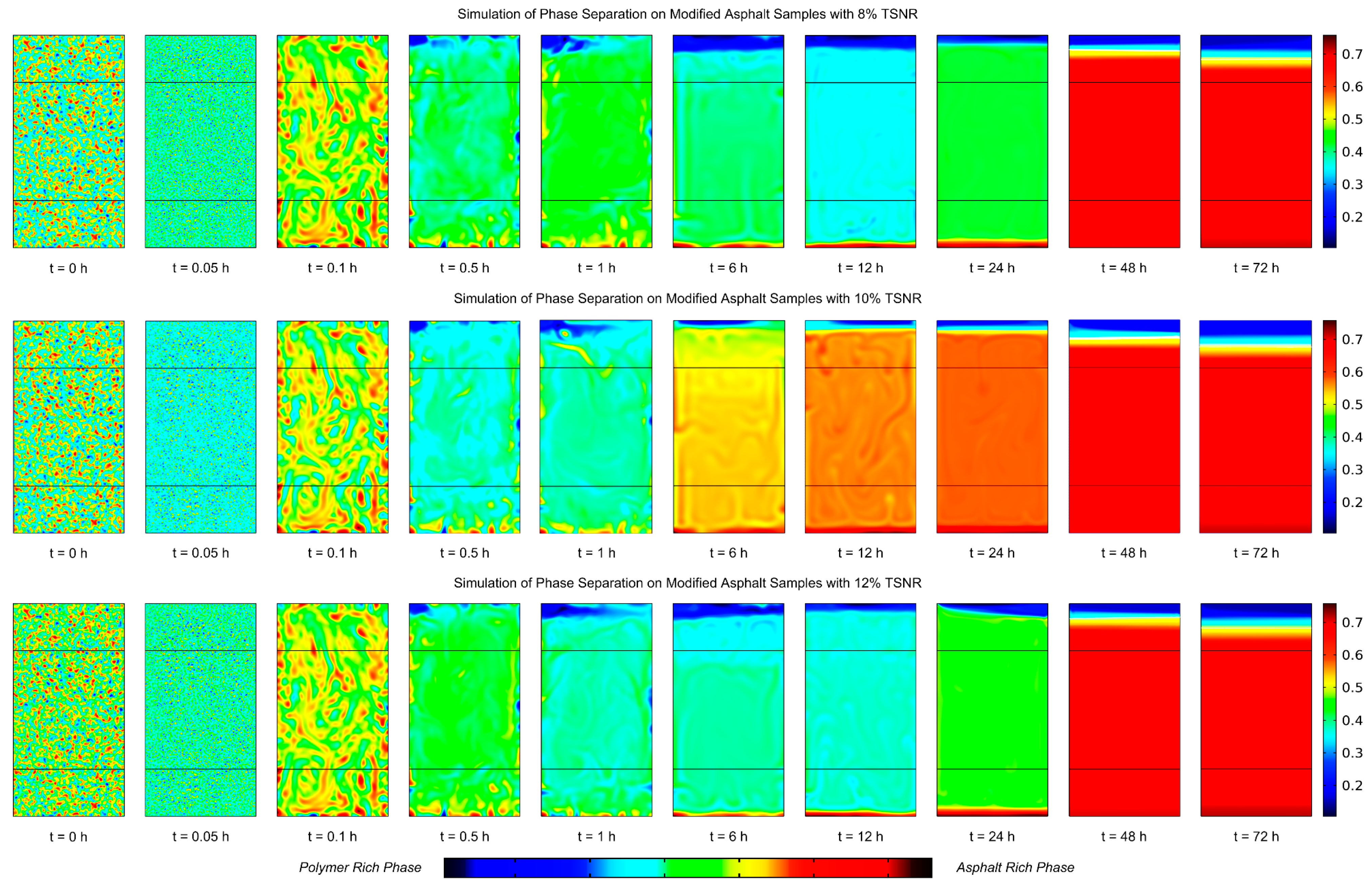
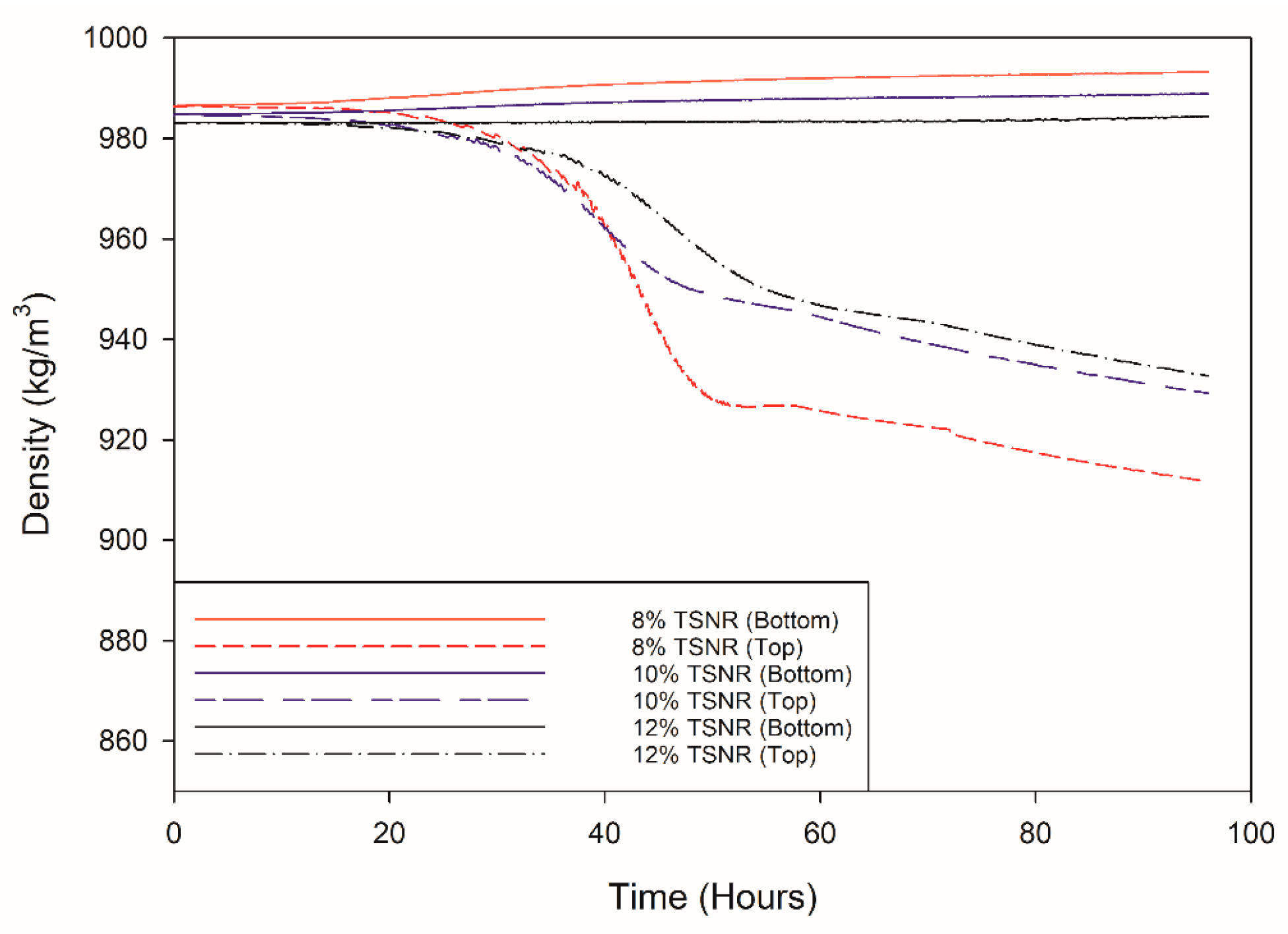
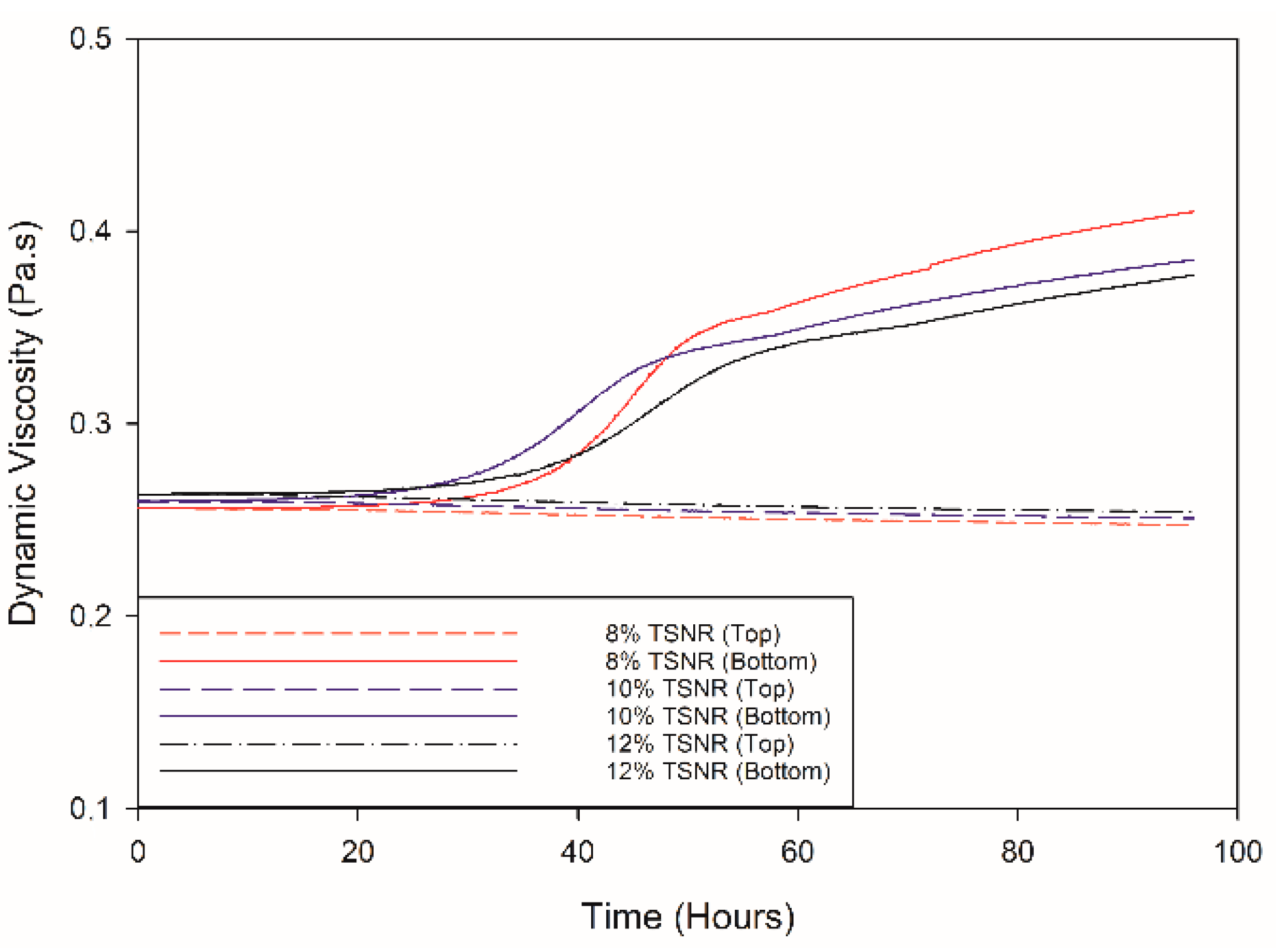
| Parameter | Test Standard | Test Results |
|---|---|---|
| Penetration at 25 ± 0.5 °C (dmm) | ASTM D5 [31] | 70 |
| Softening point (°C) | ASTM D36 [32] | 48 |
| Weight loss by thin film oven test (TFOT) (%) | ASTM D6 [33] | 0.365 |
| Penetration after TFOT (dmm) | ASTM D5 [31] | 65 |
| Ductility 25 ± 0.5 °C (cm) | ASTM D113 [34] | 110 |
| Marshall stability (kg) | ASTM D6927 [35] | 1160 |
| Sample | Temperature °C | Duration (h) | Softening Point at the Top °C | Softening Point at the Bottom °C | ||
|---|---|---|---|---|---|---|
| Non Sulfur | 1 phr Sulfur | Non Sulfur | 1 phr Sulfur | |||
| 10% TSNR | 160 | 0 | 63.8 | 63.8 | 64.7 | 64.7 |
| 10% TSNR | 160 | 24 | 52.5 | 56.2 | 60.8 | 65.1 |
| 10% TSNR | 160 | 48 | 50.8 | 53.1 | 62.4 | 63.8 |
| 10% TSNR | 160 | 72 | 47.7 | 50.4 | 61.6 | 62.7 |
| Sample | Density (kg/m3) | Viscosity (Pa.s) | ||
|---|---|---|---|---|
| Top | Bottom | Top | Bottom | |
| Aspal Pen 60/70 | 1034.670 | 1034.670 | 0.151 | 0.151 |
| TSNR | 868.560 | 868.560 | 0.517 | 0.517 |
| 8% TSNR-Modified Asphalt | ||||
| 0 h | 1023.560 | 1023.560 | 0.168 | 0.168 |
| 24 h | 992.733 | 1020.640 | 0.426 | 0.593 |
| 48 h | 987.080 | 1045.242 | 0.306 | 0.582 |
| 10% TSNR-Modified Asphalt | ||||
| 0 h | 1018.340 | 1018.340 | 0.211 | 0.211 |
| 24 h | 1004.905 | 1019.777 | 0.245 | 0.251 |
| 48 h | 977.199 | 1028.278 | 0.213 | 0.323 |
| 12% TSNR-Modified Asphalt | ||||
| 0 h | 1013.690 | 1013.690 | 0.270 | 0.270 |
| 24 h | 1002.497 | 1021.247 | 0.483 | 0.706 |
| 48 h | 993.526 | 1029.667 | 0.375 | 0.757 |
| No | TSNR Content (%) | Temperature (°C) | Density, ρ (kg/m3) | Viscosity, μ (Pa.s) | Phase Separation Rate, v (10−6 m/s) | nRe (10−5) | ||
|---|---|---|---|---|---|---|---|---|
| Asphalt | TSNR | Asphalt | TSNR | |||||
| 1 | 8 | 160 | 1034.670 | 868.560 | 0.151 | 0.517 | 3.3206 | 1.6111 |
| 2 | 10 | 130 | 1034.670 | 868.560 | 0.640 | 0.871 | 0.6756 | 0.0561 |
| 3 | 160 | 1034.670 | 868.560 | 0.151 | 0.517 | 2.8639 | 1.0093 | |
| 4 | 12 | 160 | 1034.670 | 868.560 | 0.151 | 0.517 | 2.4693 | 0.6591 |
| No | TSNR Content (%) | Temperature (°C) | Density, ρ (kg/m3) | Viscosity, μ (Pa.s) | Phase Separation Rate, v (10−6 m/s) | 𝜒 (10−5 m.s/kg) | ||
|---|---|---|---|---|---|---|---|---|
| Asphalt | TSNR | Asphalt | TSNR | |||||
| 1 | 8 | 160 | 1034.670 | 868.560 | 0.151 | 0.517 | 3.3206 | 9.633 |
| 2 | 10 | 130 | 1034.670 | 868.560 | 0.640 | 0.871 | 0.6756 | 1.960 |
| 3 | 160 | 1034.670 | 868.560 | 0.151 | 0.517 | 2.8639 | 8.308 | |
| 4 | 12 | 160 | 1034.670 | 868.560 | 0.151 | 0.517 | 2.4693 | 7.163 |
Disclaimer/Publisher’s Note: The statements, opinions and data contained in all publications are solely those of the individual author(s) and contributor(s) and not of MDPI and/or the editor(s). MDPI and/or the editor(s) disclaim responsibility for any injury to people or property resulting from any ideas, methods, instructions or products referred to in the content. |
© 2024 by the authors. Licensee MDPI, Basel, Switzerland. This article is an open access article distributed under the terms and conditions of the Creative Commons Attribution (CC BY) license (https://creativecommons.org/licenses/by/4.0/).
Share and Cite
Ibrahim, B.; Wiranata, A.; Zahrina, I.; Sentosa, L.; Nasruddin, N.; Muharam, Y. Phase Separation Study on the Storage of Technically Specification Natural Rubber Modified Bitumen. Appl. Sci. 2024, 14, 3179. https://doi.org/10.3390/app14083179
Ibrahim B, Wiranata A, Zahrina I, Sentosa L, Nasruddin N, Muharam Y. Phase Separation Study on the Storage of Technically Specification Natural Rubber Modified Bitumen. Applied Sciences. 2024; 14(8):3179. https://doi.org/10.3390/app14083179
Chicago/Turabian StyleIbrahim, Bahruddin, Arya Wiranata, Ida Zahrina, Leo Sentosa, Nasruddin Nasruddin, and Yuswan Muharam. 2024. "Phase Separation Study on the Storage of Technically Specification Natural Rubber Modified Bitumen" Applied Sciences 14, no. 8: 3179. https://doi.org/10.3390/app14083179
APA StyleIbrahim, B., Wiranata, A., Zahrina, I., Sentosa, L., Nasruddin, N., & Muharam, Y. (2024). Phase Separation Study on the Storage of Technically Specification Natural Rubber Modified Bitumen. Applied Sciences, 14(8), 3179. https://doi.org/10.3390/app14083179









